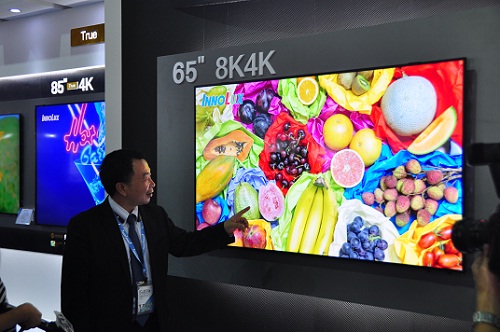The annual Touch Taiwan show took place in Taipei this month. Focusing on touch panels and optical films, the event brings together companies from across Asia, Europe and the USA. 422 exhibitors attended, stretching across almost 1,200 stands and attracting an estimated 38,000 visitors from 15 countries.
Asahi Glass had a thin glass product called XCV, to replace plastic acrylic light-guide plates. It is intended for use in LCD TVs.
Mobile devices and automotive screens were AUO‘s focus, with high resolutions and embedded touch. LCD and AMOLED units were both shown.
Using AMOLED technology, AUO had 1.5″ and 1.6″ screens for wearables. The company used a glass thinning method to lower panel thickness to 0.45mm. A 1.4″ circular AMOLED, previously shown at SID, and a 1.3″ LCD screen using LTPS and memory-in-pixel technologies, were also highlighted.
AUO’s 6″ UltraHD display reached 737 ppi, with high brightness and a wide colour gamut. Another UltraHD unit was a 17.3″ display for notebooks, with 255 ppi; this product featured 100% Adobe RGB coverage.
Integrated touch appeared on displays for mobile phones and notebooks. 12.5″ and 14″ screens featured on-cell touch (the 14″ was said to be capable of supporting a professional stylus), with in-cell units for smartphones including 5″ (a-Si) and 5.2″ (1920 x 1080, LTPS).
AUO’s automotive displays are said to feature wide viewing angles and high weather tolerance. A 12.3″ model for the instrument cluster featured ‘the world’s highest resolution’ (although no specs were shared). 8″ – 10.1″ LCD units for the centre information display (CID), as well as an 8″ on-cell touch unit, were also shown.
The last product in the mobile space was AUO’s 5″ flexible AMOLED display, which is built on a plastic substrate. A proprietary sensor meant that bending the panel manipulated the size and direction of the active display area.
In large displays, AUO was showing LCD screens with advanced features, such as UltraHD resolution, quantum dots, curved designs and HDR. The combination of all of these technologies is referred to as ‘Advanced-LCD’ (ALCD).
55″, 65″ and 85″ ALCD TV displays were shown, with a 4,000R curvature, which is intended to mimic the curve of the human eye. Colour gamut exceeds 100% NTSC, and AUO says that ‘the colour gamut specification fulfils the latest UHD 4k LCD TV standards defined by international standardisations’. Using a direct-LED backlight, panel thickness is 15mm.
A much thinner panel on exhibit was a 65″ UltraHD unit – just 4.7mm thick. AUO claims that it is the world’s thinnest UltraHD TV panel. The conventional plastic light guide plates have been replaced with glass components, which are said to simplify the panel structure.
In the public display space, AUO was showing dual-sided, low-reflection, high-brightness units, which are protected against water and dust ingress. A 65″ unit (1920 x 1080) was shown reaching 2,500 cd/m² for outdoor signage. A bright 55″ display, for vending machines, was shown for the first time. This unit supported touch.
A water- and dust-proof 46″ screen (1920 x 1080) is intended for semi-outdoor applications. It was located alongside a 38″ ‘stretched’ bar-type display and 32″ high-brightness model.
For professional users, AUO was shown 35″, 32″ and 27″ monitor displays. The 35″ unit was curved to 2,000R, while the smaller products featured UltraHD resolution and 100% Adobe RGB coverage.
Chunghwa Picture Tubes demonstrated panels for smartphones, tablets, cars, industrial control and education. Technologies on show included IGZO, AMOLED and OLED lighting.
Gorilla, Lotus NXT, Eagle XG Slim and Willow Glass products were shown by Corning.
Frank Ko, CEO of E Ink Holdings, presented a keynote speech at the linked FPD International Conference on 26th August. The presentation covered the topic of ‘Innovation and Application of ePaper Display’. Of course, E Ink also showed its electrophoretic displays, for applications ranging from wearables to digital signage.
A high-resolution (300 ppi) eReader display – the same one used in the new Kindle Voyage and new Kindle Paperwhite – was on show, as were front-lit solutions used in the Kobo Aura H2O and Tolino Vision. A 10.3″ flexible display, part of the ‘Mobius’ series being developed with Sony (Display Monitor Vol 20 No 20), was shown, featuring touch and handwriting input functions.
A large, narrow-bezel monochrome screen – formed of four 32″ electrophoretic units – and a colour model – using two 32″ units – were shown in the digital signage area. Additionally, we have heard reports that a high-brightness and high-colour-saturation 13.3″ display was at the show, for use in bus stops.
A 3D dynamic display wall, using E Ink’s Prism displays (E-Ink Shows Prism Displays for Architectural Applications), was a highlight of the stand.
As we reported last week, Innolux had a variety of large displays, scaling all the way up to a 65″ 8k unit (Innolux Goes Large at Touch Taiwan). The company also had mobile and automotive screens, though. The highlight was a high-resolution circular model, for mobiles and wearables. The 1.3″ product had a ‘high’ colour gamut and uses embedded (on-cell) touch. Innolux also had a 1.5″ transflective display, which also used on-cell touch.
 In slightly larger screens, a high-end 5″ smartphone unit was shown with in-cell touch. It was joined by a 5.5″ unit (1920 x 1080) with narrow borders and a high colour gamut, using on-cell touch and a-Si technology. Finally for phones was a 5.7″ 2560 x 1440 unit with narrow borders.
In slightly larger screens, a high-end 5″ smartphone unit was shown with in-cell touch. It was joined by a 5.5″ unit (1920 x 1080) with narrow borders and a high colour gamut, using on-cell touch and a-Si technology. Finally for phones was a 5.7″ 2560 x 1440 unit with narrow borders.
Tablets were served with a series of products, ranging from 6.8″ to 13.3″ sizes. The 6.8″ and 7″ units featured on-cell touch, while an 8″ display used in-cell.
Finally were Innolux’s automotive displays. While the instrument cluster is the main in-car area for displays today, Innolux was also showing products for the CID and rear seat entertainment (RSE) applications. Trends are towards large sizes and high resolution, contrast, colour gamut and viewing angle. These models also feature weatherproofing and anti-reflection capabilities. Innolux had an 8″ CID unit, with high contrast and accurate colours, and a 10.2″ RSE screen. A 12.3″ display was also being shown for the instrument cluster.
Separately, local sources reported that Innolux said at the show that it would begin mass production of 8k displays by Q2’16.
Taiwan’s ITRI and Heraeus were showing the integration of a Clevios conductive polymer-based touch panel into a flexible AMOLED display. The device was prepared using Heraeus’ Clevios PEDOT conductive polymer material patterned on ITRI’s FlexUp substrate. Clevios PEDOT:PSS (solution-processable and printable) was used as the transparent electrode.
The resulting flexible touch panel is a 7″ unit, which continues working after 10,000 bends at a 5mm radius.
Wisechip Semiconductor showed 0.96″ monochrome and area colour OLED panels; 1.06″ monochrome circular; 1.69″ full colour; and 2.26″ monochrome units.

